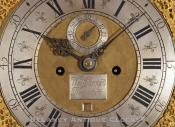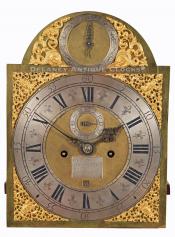A Rare Queen Anne Mahogany Tall Case Clock, by William Claggett, of Newport, Rhode Island, made circa 1760. 222088.
This rare mahogany tall clock is a good early example of Newport's high-style clocks produced during the first half of the eighteenth century. The choice of wood, stately proportions, and subtle details are indicative of the fine clocks made during this early period. This attractive clock was produced by the colonial clockmaker William Claggett [1696-1749]. William was Newport, Rhode Island's first and most prolific clockmaker. He was father to Thomas Claggett and father-in-law to James Wady. Both of which are considered prominent Newport clockmakers. These rare early clocks, produced by William, are prized by collectors as some of the finest examples of early American clockmaking. This example survives in good condition and retains an older surface on both the dial and the case.
This early brass dial retains a mellow old patina. It is composed of a brass sheet and is decorated with several decorative elements. Four cast corner spandrels frame the applied time ring. They are applied to the dial. Two additional spandrels are located in the arch. These are decorated with dolphins and help center the Silent / Strike actuator. The "Silent / Strike" positions are engraved into a brass ring that is finished in a silver wash. A hand indicates the position of this device. The engraved and silvered time or chapter ring features Arabic-style five-minute markers. Diamonds are positioned between 5 - 10, 20 - 25, 35 - 40, and 50 – 55. A closed minute ring separates the five-minute markers from the large Roman-style hour numerals. A Fleur-de-lis is engraved between each hour. An interior minute ring frames the inner perimeter of this detail. The surface of the dial inside the chapter ring has also been textured. Here one will also find a display window for the calendar day, an inset subsidiary seconds dial, and the Maker's nameplate. This large nameplate is engraved with the Maker's name. It reads," Wm Claggett / Newport. "The hour and minute hands are wonderfully hand filed. The skill exhibited here is very high.
The two-train movement is brass, eight-day duration, and is of good quality. Four-turned pillars or posts support the two large brass plates. Hardened steel shafts support the polished steel pinions and brass gearing. The winding drums are grooved. The escapement is designed in a recoil format. The movement is weight driven and designed to run for eight days on a full wind. It is a two-train or a time-and-strike design having a rack and snail striking system. As a result, it will strike each hour on the hour. This is done on a cast iron bell which is mounted above the movement.
Four compressed ball feet are applied to the bottom molding of the case. A double step is applied to the base section. The base is somewhat compressed. This is a common design detail for clock cases manufactured in the Colonies during this early period. The base molding is complex and very nicely formed. The waist section is very long and narrow. It centers a large rectangular-shaped waist door. This door is trimmed along its perimeter with an applied half-round molding. In the center of this door, one will discover a lenticle. This circular window is fitted with a piece of Crown glass. The door is hinged and opens to allow one access to the interior of the case. This is where one will find the two lead drive weights and the brass-faced pendulum bob. The bonnet design is complex. It features a caddy or sarcophagus top, which is positioned above a boxed and coffered cornice set. Two turned wooden finials are positioned on the outer corners. An intricately formed molded arch is separated by a simpler version and by a frieze. These conform to the shape of the dial door and the arched dial. The molded arch assembly is visually supported by two colonettes that are applied to the side of the dial door. These are smoothly turned and terminate at each end in brass capitals. The bonnet door is arched in form and opens to access the composite brass dial. The case has a raised sarcophagus top. This is positioned above an arched crest, set with a very finely executed blind fret-work with fabric backing. This delicate decoration remains in excellent condition. Below this is a glazed, tombstone-form dial door that is flanked by turned colonnettes with brass capitals and bases. The locking door has a brass keyhole escutcheon and opens to a composite brass dial.
This case measures approximately 101.5 inches tall. At the upper hood molding, it is 21.25 inches wide and 11.25 inches deep. This clock was made circa 1740.
Inventory number 222088.
William Claggett is included in Patrick T. Conley's Rhode Island's Founders from Settlement to Statehood. Conley's book, written in 2010, lists 57 names of the most historically significant members of the State of Rhode Island. Claggett is the only clockmaker to be included.
William Claggett was a clockmaker, watchmaker, compass maker, organ builder, engraver, printer, lecturer, author, and scientist.
William Claggett is considered one of America's earliest clockmakers. He is thought to have been born in Wales in 1696. He came to the Colonies, first to Boston sometime before 1714. He was married by Cotton Mather to Mary Armstrong on October 21, 1714. She was the daughter of Mathew and Margaret Armstrong. Their marriage record exists. In 1715, he placed his first advertisement in which he identified himself as a "Clock-Maker near the Town-House." By 1716, he had moved to and settled in Newport, Rhode Island, until his death in 1749. Here he was admitted as a Freeman. His original house still stands and is located at 16 Bridge Street. This is not true of his shop, which was located to the west of the Brick Market. This building was demolished after his death in order to make access to Long Wharf. His neighbors included the brothers Job I and Christopher Townsend, both of whom were cabinetmakers. It appears Mary died sometime around 1727. William then married his second wife, Rebecca, and she was named in his will. It should also be mentioned that William had at least five children. His son Thomas, born in 1730 and died in 1767, was also a clockmaker. William's daughter Mary married James Wady of Newport. James Wady was also a clockmaker. Two other daughters, Hannah Threadkill and Elizabeth Claggett, and a son Caleb are also mentioned in William's will.
William was civic-minded and was a member of the 7th Day Baptist Congregation as well as a founding member of Newport's local fire company. He kept close ties to Boston, and we also know that he had other interests. He was a talented engraver. So much so that he printed paper money for the state of Rhode Island in 1738. He was a merchant, as well as an author. He manufactured musical instruments and was a dabbler in science and electricity. In 1746, he put on a public exhibition of electricity. The electricity was produced and displayed by a machine he made. William performed a similar demonstration in Boston the following year. Interestingly, he gave the monies generated from these exhibitions to charity. It is also thought he introduced Benjamin Franklin to this science. Indeed, William had a first-rate mind.
Examples of his work demonstrate his ability to make high-quality clocks. Today, very few examples are known. It is well documented that he built the original tower clock for the Trinity Church. The Redwood Library & Athenaeum in Newport is the oldest lending library in America. It has an example of a tall clock that was donated to them in 1948 by Bishop Samuel Babcock, who was a descendant of the original owner, the Staton family. This clock was thought to have been made in 1723. A second clock, a wall clock made circa 1732, is at the 7th Day Baptist Meeting House. This clock is thought to have been the earliest wall clock made in America.
















